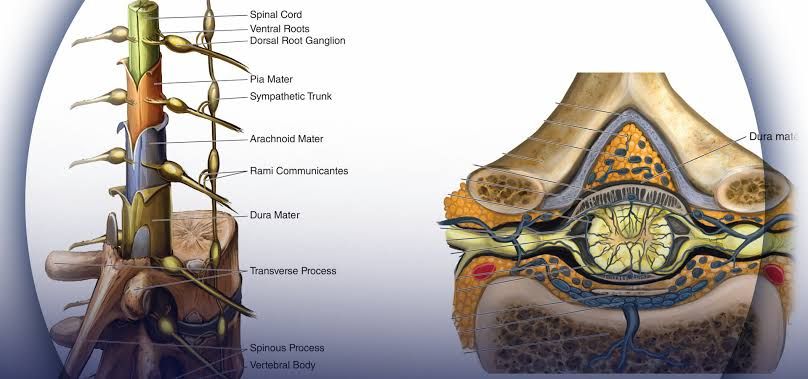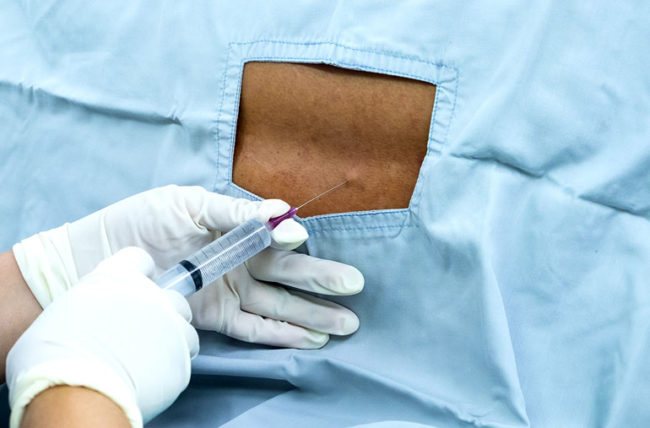
1. Procedure including Anatomy
Neuro-axial anesthesia refers to techniques that involve the administration of anesthetic agents into the epidural or intrathecal (subarachnoid) space of the spinal cord. The two primary types are epidural anesthesia and spinal anesthesia.
- Anatomy:
- The spinal cord is encased within the vertebral column and is surrounded by three protective membranes known as meninges: the dura mater (outer), arachnoid mater (middle), and pia mater (inner). The epidural space lies outside the dura mater, while the subarachnoid space is located between the arachnoid and pia mater, containing cerebrospinal fluid (CSF).
- Key landmarks for performing neuro-axial anesthesia include:
- L3-L4 or L4-L5 intervertebral spaces: These are commonly targeted for both epidural and spinal anesthesia to avoid injury to the spinal cord, which typically ends at the L1-L2 level in adults.
- Iliac crests: A useful anatomical landmark; a line drawn between them often intersects at the L4 spinous process.
- Procedure Steps:
- Preparation: The patient is positioned appropriately, often sitting or lying on their side with flexed knees to open up intervertebral spaces.
- Aseptic Technique: Sterile draping and skin preparation are crucial to prevent infection.
- Needle Insertion:
- For spinal anesthesia, a spinal needle is inserted through the skin into the subarachnoid space.
- For epidural anesthesia, an epidural catheter may be placed in the epidural space using a Tuohy needle.
- Administration of Anesthetic: Local anesthetics such as bupivacaine or ropivacaine are injected either into CSF for spinal anesthesia or into the epidural space for epidural anesthesia.
2. Indications and Contraindications
- Indications:
- Surgical procedures below the umbilicus, such as cesarean sections, hip surgeries, and lower limb surgeries.
- Pain management during labor and delivery.
- Chronic pain management in certain conditions like cancer pain.
- Contraindications:
- Patient refusal or inability to cooperate with positioning.
- Infection at the injection site or systemic infection (e.g., sepsis).
- Coagulopathy or anticoagulation therapy that increases bleeding risk.
- Pre-existing neurological disorders affecting motor function or sensation.
- Severe hypovolemia or hemodynamic instability.
3. Complications (Prevention and Treatment)
Complications associated with neuro-axial anesthesia can be categorized into minor and major complications:
- Minor Complications:
- Post-dural puncture headache (PDPH): Caused by CSF leakage from a dural puncture; prevention includes using smaller gauge needles and ensuring proper hydration post-procedure. Treatment may involve conservative measures like caffeine intake or an epidural blood patch if severe.
- Major Complications:
- Epidural hematoma: Can occur due to bleeding in the epidural space; prevention involves careful assessment of coagulation status pre-procedure. Treatment requires urgent surgical intervention if significant compression of neural structures occurs.
- Infection: Meningitis can arise from contamination during procedure; strict aseptic technique is essential for prevention. Treatment involves antibiotics based on culture results.
- Neurological Injury: Rare but serious; can result from direct trauma during needle insertion or hematoma formation. Prevention includes proper technique and anatomical knowledge; treatment varies based on severity but may include surgical decompression.
In summary, neuro-axial anesthesia is a valuable technique with specific indications, contraindications, potential complications, and necessary precautions that must be understood by practitioners to ensure patient safety.







